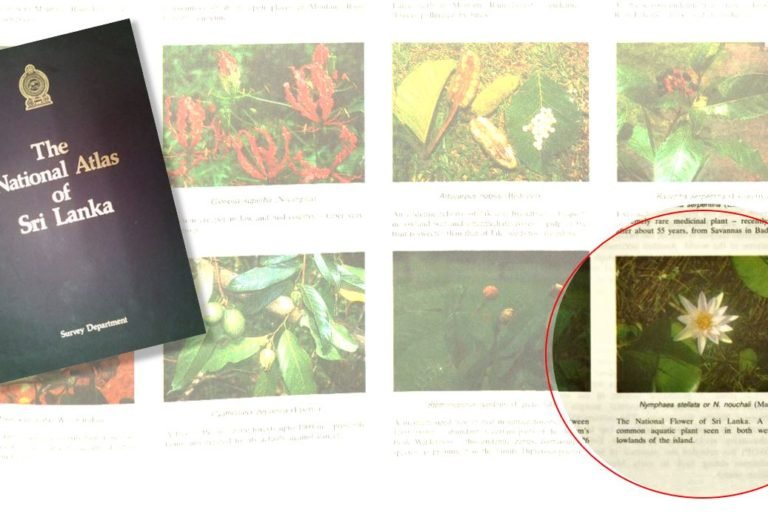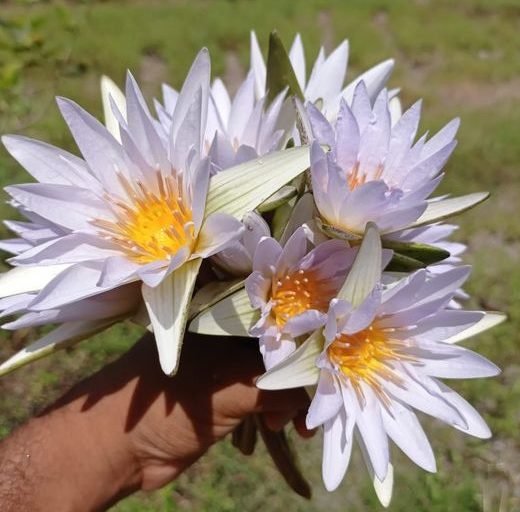- In 1986, Sri Lanka named a native blue water lily, known locally as nil manel, as its national flower, but a mistake in the official declaration meant an introduced species, violet in color and known as dam manel, has since been widely promoted as the national flower.
- Presidential greeting cards, postage stamps and school textbooks are among the official publications that propagated the mistaken identity, despite consensus from the scientific community on what the true species is, and despite later government efforts to correct the mistake.
- A 2017 study shows the blue and violet lilies are naturally hybridizing, further complicating efforts to disentangle the two, and prompting calls to select a new national flower.
- Several eye-catching candidates have been proposed, including the pink-and-crimson Vesak orchid (Dendrobium maccarthiae), binara (Exacum trinervium), and ma rath mal (Rhododendron arboreum zeylanicum).
COLOMBO — As a school student in Sri Lanka in 1986, Deepthi Yakandawala sent a greeting card to the country’s president, J.R. Jayewardene, for Vesak, the holiest day in the Buddhist calendar. Presidents past and present have occasionally responded in kind, and in Deepthi’s case, she received a card back with a picture of violet-colored water lilies.
This particular flower had just been declared a few months prior as the national flower of Sri Lanka. Except that it wasn’t. And for the young Deepthi, it never occurred to her at the time that an official card sent by the president would show the wrong flower.
But it wasn’t just the presidential greeting cards. Government newspapers, postage stamps, school textbooks — over the years all would bear pictures of the same violet water lily that they identified as nil manel in Sinhala and neelothpalam in Tamil, Sri Lanka’s official languages.
Fast-forward to the present day, and Deepthi Yakandawala, now a prominent plant taxonomist and professor of botany at the University of Peradeniya, is leading a campaign to correct a mistake that has persisted over the decades.
The ‘real’ national flower
Sri Lanka’s national flower was declared at the same time as its national tree, the Ceylon ironwood (Mesua ferrea), in February 1986. But the selection committee omitted to include an image of the flower in its report, describing it only as Nymphaea stellata, a pale blue water lily.
The very first time the public heard about the declaration of the national flower was in an article published March 1 that year in a state-run Sinhala daily newspaper. And that’s where the mistake was born. The photo accompanying the article wasn’t that of a pale blue flower, but a violet one, a hybrid water lily species now believed to have been introduced into Sri Lanka in the early 1970s as an ornamental plant.
The mistake rippled out from there. A postage stamp commemorating the declaration also carried the wrong flower. School textbooks identified the purple water lily as Nymphaea stellata. And the president sent out Vesak greeting cards showing the same flower.

Not everyone got it wrong, however. The 1988 edition of the National Atlas, published by the Survey Department, carried the image of the correct — pale blue — water lily. But all other government institutions continued to use the wrong — violet — image, further ingraining this mistaken identity in society. It didn’t help that the violet flower, an invasive species, was larger and more widely distributed, and therefore more easily recognizable, than the less common blue one.
In the meantime, Deepthi had gone on to study botany at the University of Peradeniya. She published prolifically, and earned her doctorate from the University of Reading in the U.K., before returning to her alma mater, where today she heads the Department of Botany. Along with her husband, Kapila Yakandawala, from Wayamba University of Sri Lanka, she began raising the issue of the national flower’s true identity with the authorities around 2010. The pair also suggested that the scientific name for nil manel should be Nymphaea nouchali, often known by its synonym Nymphaea stellata.

Calls for correction
In 2011, the Ministry of Environment convened a committee to clear up the confusion. Among the recommendations it issued were that the ministry publicize and popularize the correct flower and ensure the use of the correct image by all government departments. But while the government approved the recommendations in 2015, the wrong identity continues to prevail. In recent weeks, Parliament’s Committee on Public Accounts (COPA) has instructed the Ministry of Environment to carry out a campaign to raise public awareness.
Meanwhile, the Yakandawalas continued studying the water lily and found the violet variety and the native blue one were hybridizing. They named the violet invader Nymphaea × erangae. Their discovery of populations of water lilies with intermediate characteristics between the native Nymphaea nouchali and Nymphaea × erangae showed that natural hybridization is common in this family of plants, and highlighted the importance of conserving the unique genetic identity of the native species.
Even though the public continued to be fed images ofthe wrong flower, the scientific community was aware of the mistake, says Magdon Jayasuriya, a plant ecologist. Jayasuriya was responsible for the sole official instance where the correct flower was identified: the 1988 atlas.

Botanist L.K. Senaratna, from the Open University of Sri Lanka, was another who caught on early. She says she recalls that as soon as the first picture of the wrong flower was published in 1986, her father, B.A. Abeywickrama, an emeritus professor at the University of Colombo, pointed out the mistake. “However, the wrong type of flower proved more attractive than our paler and less conspicuous but very beautiful nil manel,” she says. “The [Ministry of Environment] committee’s recommendations fell on deaf ears and thus the wrong flower continued to enjoy its status as the national power.”
The 1986 committee that selected the national flower used several criteria to make its choice, such as endemicity (whether the species is found only in Sri Lanka), utility value, historical and cultural significance, appearance, distribution, and reproducibility with cultural significance. Another condition was that the selected flower should not be a flower of another country. That should have ruled Nymphaea nouchali out of contention, as a white variant of this water lily had already been adopted as the national flower of Bangladesh back in 1971.
Given all the confusion about Sri Lanka’s national flower, the country might be better off selecting a new flower that can be clearly identified and that’s undeniably unique to Sri Lanka, says Jagath Gunawardena, a veteran environmental lawyer and naturalist who was a member of the 2011 committee that recommended measures to correct the mistake. If a new search ensues, he says, he already has a favorite: the Vesak orchid (Dendrobium maccarthiae), an endemic and beautiful flower in pale pink and crimson.

“We shouldn’t be hesitant in selecting a new national flower if the existing one has a confusing identify, as [the concept of a national flower] shouldn’t be concrete,” Pradeep Rajatewa, founder of the Flora Sri Lanka website, tells Mongabay. He points out that Sri Lanka in 1991 changed its national sport, from the baseball-like game known as elle to volleyball.
Rajatewa says there are plenty of candidates from which to select a new national flower for Sri Lanka. Among them, the endemic binara (Exacum trinervium macranthum), ma rath mal (Rhododendron arboreum zeylanicum) and ran dothalu (Loxococcus rupicola) should be some of the key contenders, Rajatewa says.
Citations:
Yakandawala, D. M., Kumudumali, D. P., & Yakandawala, K. (2017). Evidence for interspecific hybridization between exotic ‘Dam manel’ (Nymphaea × erangae) and native ‘Nil manel’ (Nymphaea nouchali Burm. F.) in Sri Lanka. Ceylon Journal of Science, 46(3), 81-91. doi:10.4038/cjs.v46i3.7445
Banner image of the nil manel, Sri Lanka’s national flower, courtesy of Aruna Yasapalitha.












